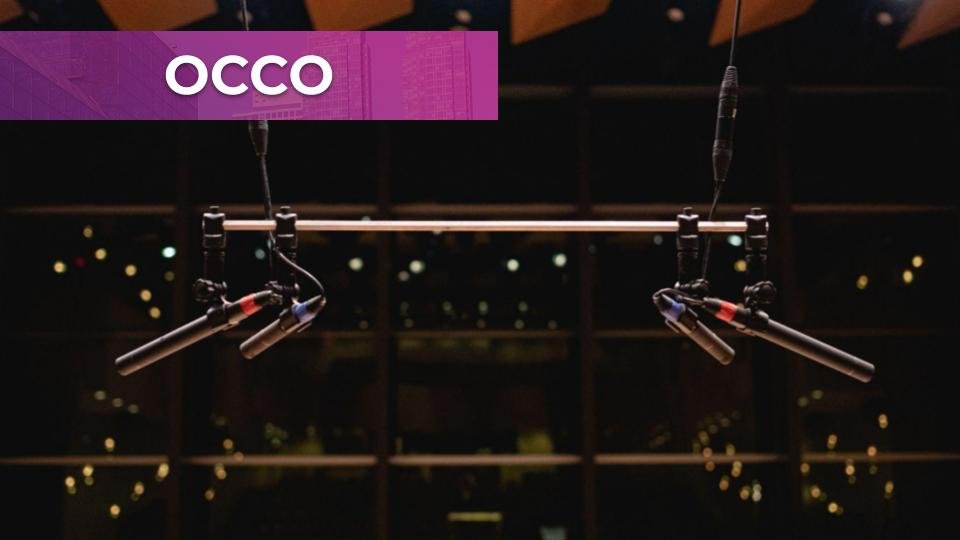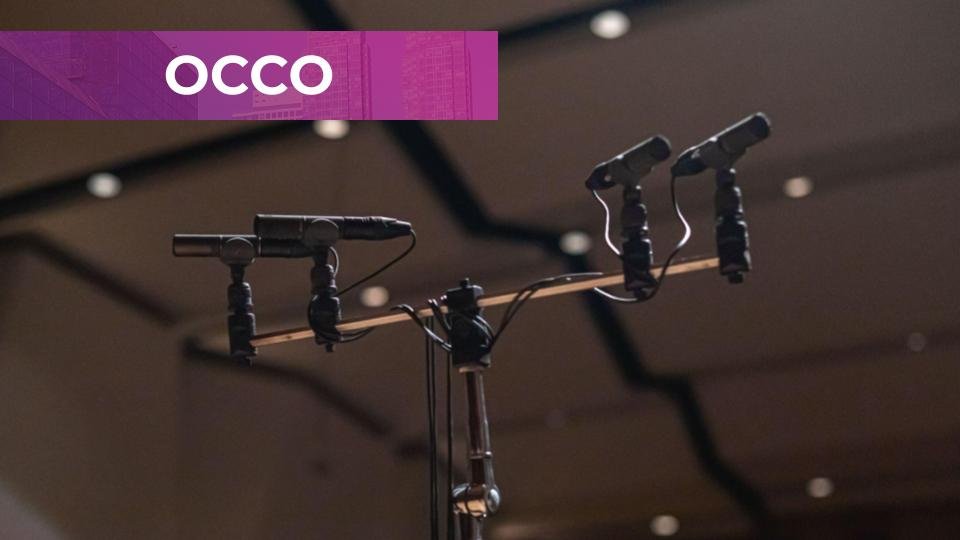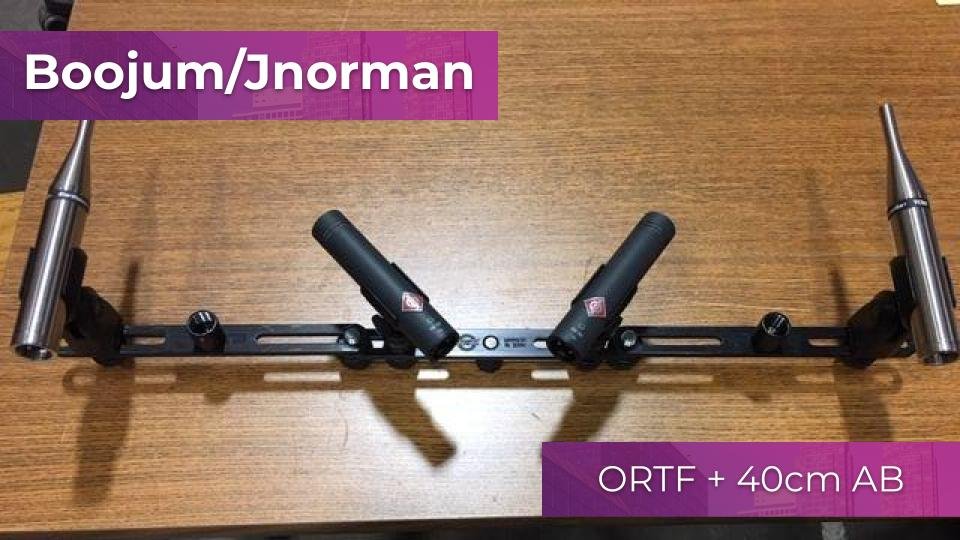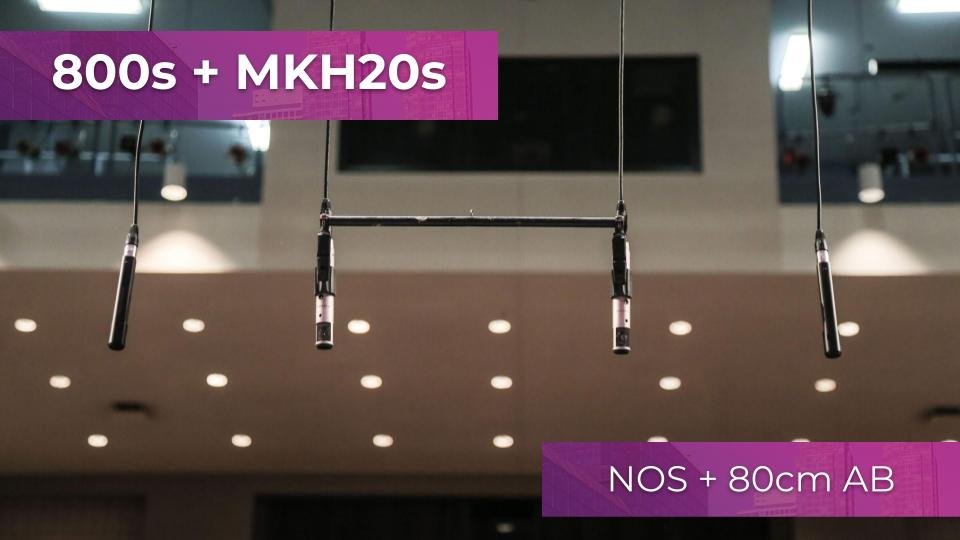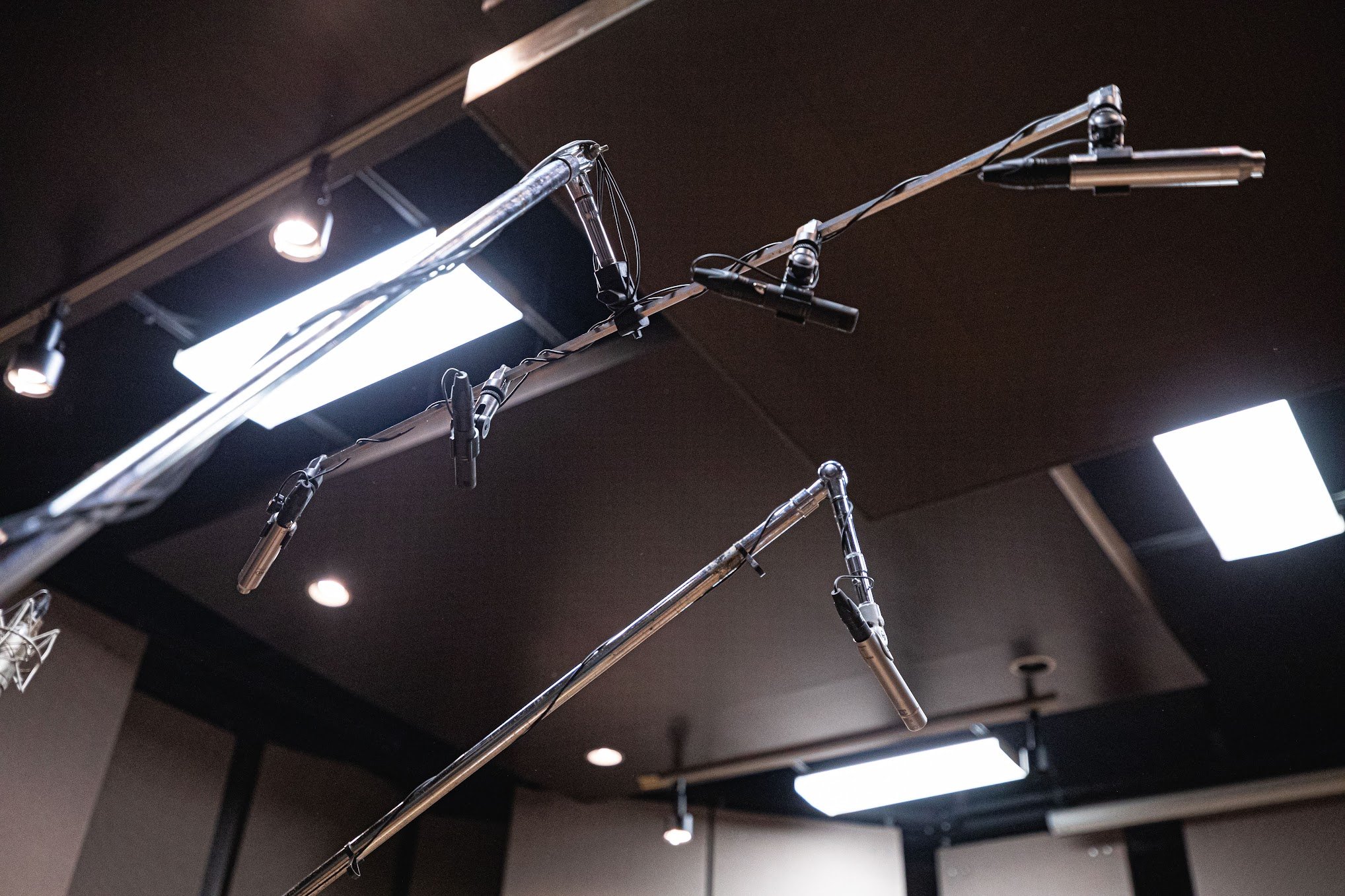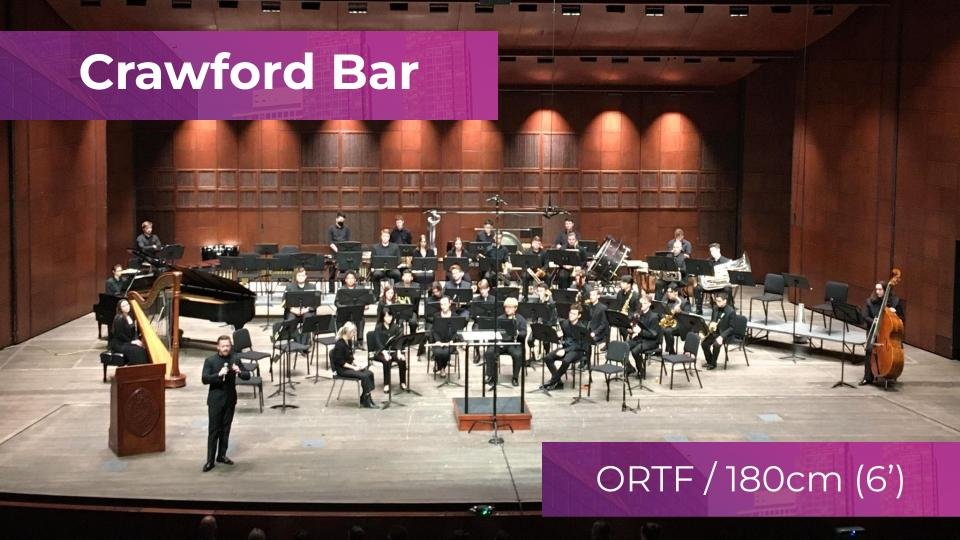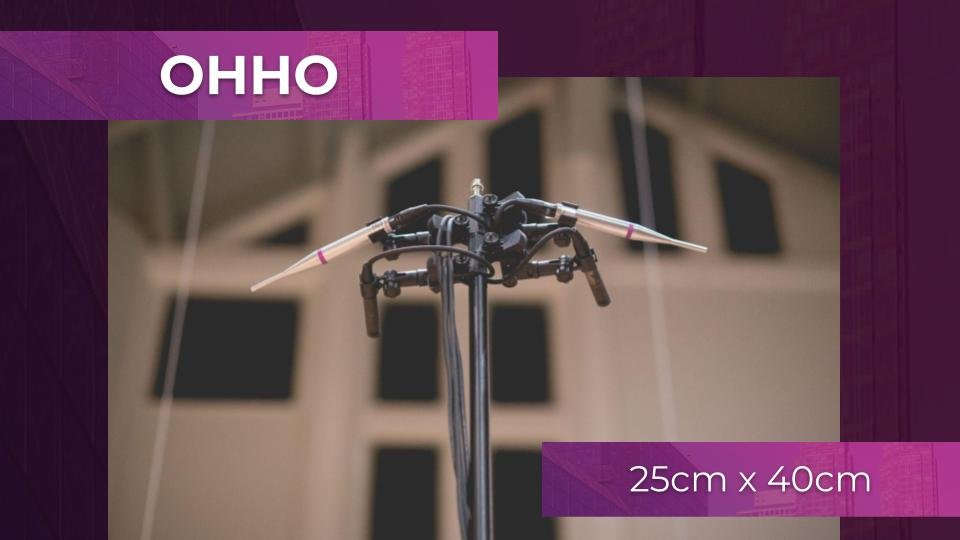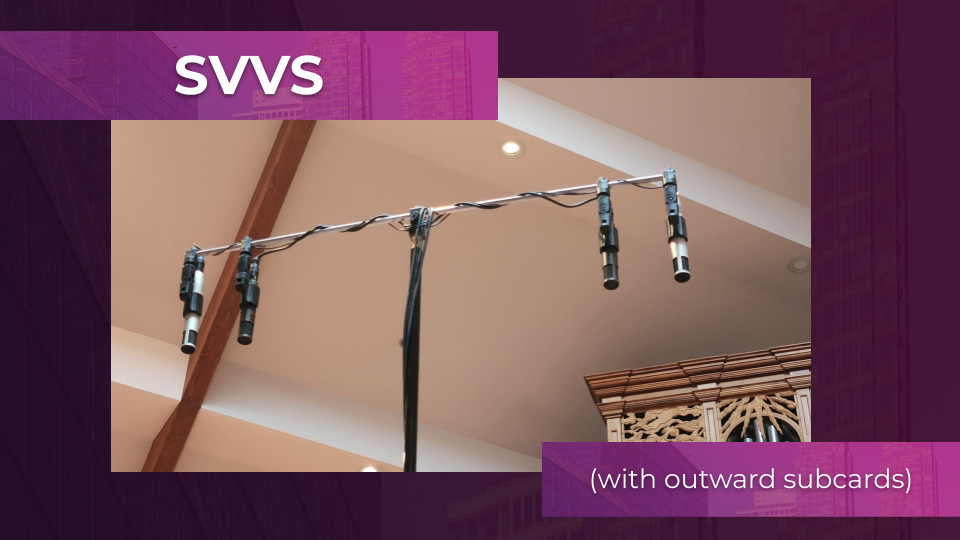OCCO Stereo Recording ARRAYs
The following information is adapted from the October 2022 AES presentation “New Frontiers: The Secret Menu of Stereo Recording".
Author: Christian Amonson
OCCO Array with the Kansas City Symphony
OCCO Array with the Grand Rapids Symphony
Prologue: When I began recording, I frequented online forums where engineers argued with each other about what mics were best and which pattern was ideal for recording classical music / acoustic ensembles. “Nothing sounds as open as an omni microphone. It’s true to the source and doesn’t sacrifice any low end.” “When is the room ever perfect? I’ll stick with cardioids - they give me reach and detail.” “Subcardioid mics give me the best of both worlds - I use them for both mains and spots.” It was contentious, with opinions held steadfast and strong. I appreciated the conversations, and I set out to test omnis and cardioids (and other patterns) as much as I was able. For every recording, I began putting up two arrays, often (but not always) a pair of cardioids and a pair of omnis. First I did 20 recordings, then 200, and then 1000. What I learned: one pair alone was almost never the most musical choice for an entire recording. Each pair was useful, usually in conjunction with the other. Perhaps I was recording a mass choir with 120 singers and everything sounded great in the omnis with a touch of cardioids. But then a soloist would sing and the omnis now had too much audience, too much HVAC, and not enough reach. Luckily, I could switch to the cardioids, and it was like I “leaned in” closer to the performer(s). Eventually, I made recording with multiple arrays the default approach for my recordings. It allowed me to be responsive to the music, the client, and the changing requirements of spaces and rep. But I didn’t have a way to talk about it. Enter OCCO, OVVO, OHHO, SVVS, et al
WHAT IS OCCO?
OCCO is a stereo recording technique based on using an omni pair (outside) and cardioid pair (inside pair) of microphones on the same plane. Omni, cardioid, cardioid, omni. The pairs can be mixed together or used independently. Each pair should be correlated, with an image that can be used on its own without the other pair.
OCCO is a flexible alternative to single-pair and single-pattern techniques (Iike XY, ORTF, NOS, AB, LCR, Decca Trees). The advantages are many:
the pattern of the array can change to accomodate different instrumentation/ensembles within the same setting
the pattern of the array can change to accommodate different orchestration/genres/style of the same ensemble
a larger sweet spot in venues known/unknown
greater ability to accommodate client requests in post production
infinitely variable between omni and cardioid
“phased array” reach into the ensemble*
Saying goodbye to the old favorites… but maybe not…
OCCO: The Specifics
OCCO is not one specific array: it is a category of arrays. It’s an approach / philosophy that uses two pairs of microphones (one cardioid pair, one omni pair) to create an overall four-mic array with a flexible pattern.
OCCO can be built from “the usual suspects” of stereo recording. Consider ORTF and 40cm AB aka the Boojum/JNorman array (two engineers who started using the same set-up independently). It’s an OCCO array. Or consider NOS and a 90cm AB pair. It’s also an OCCO array. Each array uses a pair of cardioids on the inside and a pair of omnis on the outside. By blending to taste, you create a new pattern for the overall array that is different than any individual microphone or pair. The tone of the array also becomes a hybrid.
OCCO: Mics
Any mics that work for regular single-pair stereo arrays can work fine for OCCO arrays, but there are ~two different philosophical/musical directions you can go with your combinations.
Option 1: using two pairs with a similar tonal profile. As you vary between the pairs, the tone of the recording does not change significantly. For instance, using Sennheiser MKH800s and MKH20s like the picture above.
Option 2: using two pairs with a distinct tonal profile.
2A: If the omnis are darker than your cardioids, you exaggerate the sense of space. The brightness of the cardioids gives you more reach when you need it, and the darkness of the omnis pushes the perspective back and/or emphasizes the darker reflections, adding more “space.”
2B: If the omnis are brighter than the cardioids, you can add more “air” and retain the detail in the distant sources / direct sound, even while increasing the amount of room (which has usually absorbed that high frequency information).
Example: “The President’s Own” U.S. Marine Band uses [bright] Josephson CO-100K mics on the outside of their array. On the inside, the use variable Sennheiser MKH800 Twins, which I would argue are tonally very similar to the Josephsons. (Twins have “reach”.) But if swap that MKH800s out for MKH8040s, then you’d have dark cardioids and bright omnis. Or if you swap out the Josephsons for 8020s while keeping the Twins, then you’d have bright cardioids and dark omnis.
What about large diaphgram vs small diaphgram?
My pictures mostly show small diaphgram condensers, but it’s certainly possible to use large or medium diaphragm condensers. (Some of the reasons I and many others use lots of SDCs in classical recording: easy to pack, easy to travel with, easy to hang, no bulky power supplies, and a generally advantageous/consistent off-axis frequency response.)
OCCO: Angles
When given the chance, I prefer to angle my omnis outward. This is because very few omni microphones are omnidirectional throughout all frequencies. The higher the frequency, the more directional the mic is (unless you are working with Earthworks QTC or miniature DPAs). With that in mind, angling the microphones out creates amplitude differences that correspond with / reinforce time of arrival differences.
Angling microphones may also help you get the capsules aligned in the same plane. In the image above, you can see the Earthworks QTC40 microphones angled out almost 160* degrees, just for this purpose. There’s nothing special about 160*. And in the second image above (Sennheiser 8040s and Schoeps MK2Hs), both pairs are angled out 90 degrees and the capsules are still in line.
If you don’t have experience or preferences with microphone angles, I recommend having your cardioids at 90 degrees, and then angling your omnis at whatever angle gets the capsules in line with the cardioids capsules.
OCCO main array with sacrificial Center omni for demonstration.
OCCO with Neave Trio at Zankel Hall, Skidmore College.
OCCO: Imaging
Stereo imaging and localization (the ability to tell the direction and distance of a sound) are derived from time-of-arrival differences (the differences in time between when a sound hits one mic and when it hits the other) and amplitude differences (the differences in level on one side vs another).
Time-of-arrival differences are determined by the distance between the mics.
Amplitude differences are determined by the overall polar pattern, frequency-dependent directivity, and the angle of the mics relative to each other.
With OCCO, you have two images, one from each pair of mic. Ideally, these images reinforce each other, creating a vivid and consistent image that does not draw attention to itself when changing the relative levels of your pairs. From all cardioid to all omni and back, you want the ability to change the pattern of your overall array without dramatically changing the image. Do they need to be exactly the same? I don’t think so, and many engineers find a tiny bit of extra width in the omnis to be both pleasant and necessary to compensate for the reduced amplitude differences. Pointing the omnis outwards also improve the localization and correlation to the cardioids, since most omnis are not truly omni. The higher the frequency, the more directional an omni is likely to be. (Check the charts!)
Time-of-arrival differences are the most important cues for your brain, which is why I don’t use ORTF. Even with cardioids pointed 110* away from each other, the image fails stretch all the way left-to-right. 17cm spacing doesn’t give enough time-of-arrival differences. Things start to feel more like reality as you go to NOS (30cm), but I find DHT to be a better starting point, and easier to measure (35-38cm). Try cards at 35, 40, 45, 50cm, and see if you have a preference. In the KC Array (top of page), the spacing is cards at 50cm with omnis at 120cm. Othertimes, my omnis are nearly touching the cardioids. I’m much pickier about the spacing of my cardioids than my omnis, but I don’t go beyond 120cm for the omnis. I’m usually not traveling with a bar that long anyways.
OCCO: Phased Array Properties
The more mics you have on a single plane, the more directional the pattern of the array becomes. Even an array of omnidirectional microphones can be hyper directional if you have enough of them. The pattern of the array can be different than the pattern of the microphones.
Much of the excitement over four-mic arrays in recent years has been around the “phased” properties of the array. The idea is: a second pair of microphones in line with your first pair gives you more “reach” into the center of the ensemble. Anything along the 0* center axis of the array hits all four microphones at the same time, and receives a boost relative to those sources farther away from the 0* axis which do not hit all the mics at the same time. Source not along the center line do not receive [as much of] a boost, and may even experience additional filtering that subtly reduces the level.
Conceptually, this is absolutely true. Even a single pair of omnis does not result in an omni pattern. It is slightly elliptical. And the more omnis you add, the more it starts to look like a football. However, in practice, adding a pair of omnis to a pair of cardioids doesn’t make the group feel closer. It does the opposite. And adding a pair of cardioids to omnis does make the group feel closer, because you are adding in more direct sound and less indirect sound. But that’s a result of the pattern, not the phased-arrayness.
There is something to be said however, about the way a two-pair array can often feel more full or “bigger” than either single array. Perhaps this is the preserved alignment (phase) and subsequent boost in lower frequencies that is not as apparent in higher frequencies. So... phased-array properties are there, but it’s hard to quantify casually, and it’s not the selling point of OCCO. (A pair of cardioids will sound closer without the omnis!) But consider it a happy-accident.
OCCO: Samples
What pattern is used in each video? I couldn’t say, and I don’t keep close track. I just use what sounds good for any particular piece, passage, phrase, or ensemble.
OCCO: What it’s not.
An OCCO array isn’t the only way to control your direct-to-indirect sound in a mix. For instance, adding room mics into your mix can change your perspective. Or removing distant mics (like room mics or mains even) can move the listener closer. However, the mics are not functioning as a single array and should not be considered OCCO. It’s just room mics.
The same is true for approaches that have two pairs in closer proximity, but still on distinctly different planes. For instance, if one pair (perhaps cardioid) is 2 meters from the source and another pair (perhaps omnis) is 3 meters from source, it’s just two separate pairs/arrays. They are not a single in-phase array with a variable pattern.
Other arrays with four mics in-a-row/on-a-bar, like the [Marc] Aubort Four or the four-mic [Tony] Faulkner Array (not to be confused with the 2-mic Faulkner Array of parallel figure-8s at 20cm) aren’t OCCO, because they aren’t omnis+cardioids. (I’d call them OOOO and OSSO, respectively.)
Cardioid mains with omnis flanks (also known as “wides” or “outriggers”) is another popular approach for recording. While the technique shares cardioids-on-the-inside and omnis-on-the-outside with OCCO, it does not function as a single array. Flanks are decorrelated and cannot be used on their own. They can only supplement the main array by decorrelating the low end and adding some additional reflections.
What is the line dividing OCCO and mains+flanks? That is up to you, but there is some consensus that moving beyond 4’ or 1.5m creates a hole-in-the-middle. It’s “too far”. For instance, the Crawford Bar used by engineer Joel Crawford uses ORTF and omnis at 6’ on a single bar. “I wouldn’t use the omnis on their own.” Almost, OCCO, but not quite. The TT-Array used by engineer Ben Zabelski is similar: ORTF and omni at 4’ on a single bar. “I never used just the omnis.” Functionally not OCCO for Brad, but for another engineer, perhaps it might be.
What about taping a cardioid mic and an omni mic together so you can vary the pattern without needing a bar? You are in good company! Volker Straus (1936-2002) was the OG explorer of liminal patterns. When the only patterns available to him were omni, cardioid, and figure-8, he taped omni and cardioid mics together (called a “Straus Paket”) to create a subcardioid pattern. When channel count was limited, he Y’d the cables together, creating a fixed subcardioid “virtual” mic/array. When channels were available, he routed them separately, creating the ability to vary the pattern infinitely between omni and cardioid. This is the spirit in which OCCO continues! I’d say this is the closest you can get to OCCO without quite doing OCCO. It’s a great solution for when you don’t have a bar or for if you prefer your cardioid and omni spacing to be the same. It will not have “phased array” properties, since you only have two point-sources instead of four. (Though you could argue for some phased array properties on the vertical plane if your mics are stacked like the picture below.)
OCCO: The Nomenclature
OCCO isn’t the only category of arrays that use two correlated pairs of mics on the plane. The letter-based, order-based nomenclature allows us to identify other categories as well. I use OVVO just as much as OCCO:
OVVO - Omni, Variable, Variable, Omni
OHHO - Omni, Hyper, Hyper, Omni
OSSO - Omni, Subcard, Subcard, Omni
OOOO - Omni, Omni, Omni, Omni
SVVS - Subcard, Variable, Variable, Subcard
OHNO - You forgot to hit record.
and more. Like OCCO, these do not indicate the spacing of the mics, nor the model. They are categories of arrays.
The nomenclature can also be used for arrays that include more than two pairs, though abbreviating the indentifier to just one letter (but continuing outside to inside), may be more sleek. For examples: O8C.
OCCO, et al: Getting Started
Start by combining arrays you are familiar with.
Look for contrasting pickup patterns.
Play with contrasting vs complimenting tone.
Don’t be afraid to change the mix/ratios.
Think about the pattern/sum of the array, not the mics.
Make sure each pair is good by itself.



